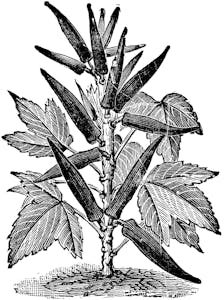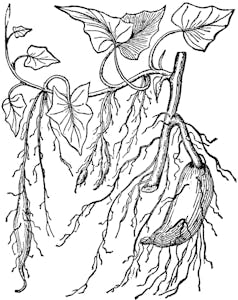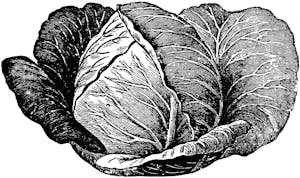Surviving in the Slave Community
Those enslaved at Oak Alley were issued rations of dried cod or pork. Such rations did not come close to the caloric intake needed by workers laboring 12-14 hours at a time, leaving enslaved men and women with the additional task of undertaking their own gardens, often weeding and watering their crops whenever they could find the time.
Many of the crops grown by those in the community were those with African origins, connecting the gardener with their history across the Atlantic, in spite of slavery. Others, such as mustard greens and yams we now know to be remarkably nutrient dense, provided much-needed vitamins and trace minerals. Looking at their rations from a modern perspective, we can see a much more varied and healthy diet than what they were assigned. In addition, some raised chickens, who were watched by younger children during the day, and put up in roosts close to the quarters at night.

Below are just a few of crops undertaken by the slave community:
Okra was introduced to the Americas from Africa via the slave trade and was common in plantation gardens, particularly those in the enslaved community. The southern stew, gumbo, gets its name from the Bantu name for Okra, ki ngombo.

Watermelon is thought to have originated in southern Africa. French explorers also found the fruit being cultivated by indigenous communities in the Mississippi Valley. With their large sweet fruit and spreading vines, watermelons require a great deal of space to grow.
Cowpeas are a legume that are also called field peas, black-eyed peas and southern peas. Originating in Africa, they were popular on plantations because they could be dried and stored for long periods of time before being consumed. Today they are most commonly referred to as black-eyed peas. 
Sweet Potatoes, and their relation, yams, originated in Middle/Southern America and were cultivated by Native Americans, followed by French and Spanish settlers. They were routinely grown in plantation gardens for sweet or savory dishes
Corn, also known as maize, was widely cultivated in Mesoamerica before spreading through much of the continent by 2500 BCE. It was a vital staple for both slaves and plantation animals.

Cabbage was brought to the Americas in the mid-16th century and then cultivated by colonists. Enslaved laborers cultivated cabbage to varying degrees and used the hearty leaves in soup.
Mustard Greens were an integral part of a slave’s diet. Rich in nutrients, they were easy to grow and served as a substitute for the greens available in West African regions.
